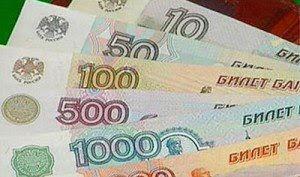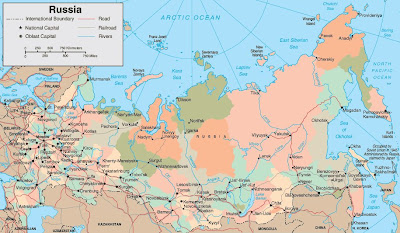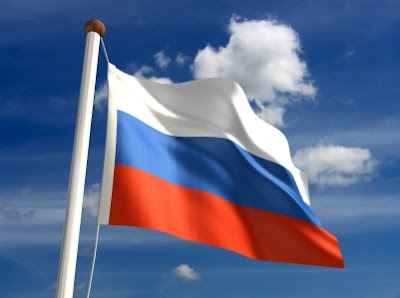Below is the information I find absolutely necessary for each newcomer to know about this 'one-of-a-kind' in so many respects, country. Don't expect here a whole treatise, my point was just to hightlight the most important things...I do it as I used to watch how many people abroad get confused or unaware of even basics.
So, Russia is:
1. A largest country in the world (more than an eighth of the Earth’s land area) that covers 11 time zones and spans 9000 kilometers from east to west and 5000 from north to south. Ural mountains leave 1/4 of Russian territory in Europe and the rest part - in Asia. Total area of Russia is 17,075,400 square kilometers (6,592,800 sq mi, for comparison: like USA and Europe together).
2. The country of beautiful, vast landscapes (if you come by a plane, your first impression about Russia is likely going be never-ending forests and lakes, scattered among them), it occupies most of Eastern Europe and north Asia, stretching from the Baltic Sea in the west to the Pacific Ocean in the east, and from the Arctic Ocean in the north to the Black Sea and the Caucasus in the south. It is bordered by Norway and Finland in the northwest; Estonia, Latvia, Belarus, Ukraine, Poland, and Lithuania in the west; Georgia and Azerbaijan in the southwest; and Kazakhstan, Mongolia, China, and North Korea along the southern border.
3. The country used to have its own, unique, ''Eurasia'' mission. Let me explain what it means: Russia historically and geographically has been (and remains till today) the home to people of many various nationalities and customs. This diversity is so salient that the country is often called a "bridge" between Europe and Asia. One need to remember though, that while this allegory is quite accurate, it still is based on pure geography. The reality is that Russia is not just a thrilling mix of Europe and Asia but also the country that has always been culturally oriented towards the West. More importantly, the recent influx of western lifestyle and values made it possible to create subcultures similar to these you can find in any other major country, opened to the outside world's information.
4. However, they say for a reason that Russia is the country of vivid contrasts and vibrant life. Visit a Russian village, and you're going to feel like you're back one century ago. Often even primitive facilities lack here. People are mostly engaged in farming and enjoy quite modest pleasures. Certainly, this traditional way of life leaves it virtually impossible to crave for all these fancies the megapholis seduces you.

But visit the capital and largest city of Russia - Moscow (''Moskva'' in Russia), an d be ready to be charmed with rich Russian history and culture (just a few sights to see: Kremlin and Red Square, Tretyakov Gallery and Bolshoi Theatre, Pushkin Museum of Fine Arts) and also totally stunned with frenzied pace of modern Moscow's development.
d be ready to be charmed with rich Russian history and culture (just a few sights to see: Kremlin and Red Square, Tretyakov Gallery and Bolshoi Theatre, Pushkin Museum of Fine Arts) and also totally stunned with frenzied pace of modern Moscow's development.
Thus, The Moscow City complex (Москва-Сити), Moscow International Business Center will give you full impression on that amazing and invigorating transformation from Communist monolith to contemporary, free-market metropolis, Moscow currently goes thru!

If you are aesthetic, do explore faschinating St. Petersburg (the second largest city, also known as "Northern capital"). This cultural center of Russia and heart of former Russian aristrocrasy, certainly one of incontestable highlights of the continent. In fact, its impressive imperors' palaces, crumbling Italianate mansions and picturesque canals are so beautiful that it is often called "Venice of the North".
 However what really makes St. Petersburg (or ''Piter'' as Russians fondly call it) one of Europe's most magnificent cities is its world-famous cultural treasuries: monument to Peter the Great and Catherine II, Saint Isaac's Cathedral, Church of the Savior on Blood, the Hermitage Museum, The Mariinsky Theatre, The Peter and Paul Fortress, The Russian Museum (devoted to the Russian fine art specifically ), Admiralty building, and finally illustrious Nevsky Prospekt (which is now perceived as the main street of the city).
However what really makes St. Petersburg (or ''Piter'' as Russians fondly call it) one of Europe's most magnificent cities is its world-famous cultural treasuries: monument to Peter the Great and Catherine II, Saint Isaac's Cathedral, Church of the Savior on Blood, the Hermitage Museum, The Mariinsky Theatre, The Peter and Paul Fortress, The Russian Museum (devoted to the Russian fine art specifically ), Admiralty building, and finally illustrious Nevsky Prospekt (which is now perceived as the main street of the city).

For venturers by heart, Russia also offers traveling to small Kaliningrad, Russian enclave, wedged between Lithuania and Poland and finally, as the last travel titbit - Siberia, the famed outpost of former Russian empire.
Whatever destination you choose, you won't be disappointed. Maybe things are not always easy or hassle-free here in regard practical matters but huge number of world-famous sights and attractions is guaranteed to make your stay unforgettable. I know, to some these contrast can seem too drastic but to me, it's all about the seeking the difference, about constant change Russia is in now, which fulfills this dynamic country with lots of energy and potential and actually...and actually is responsible for a lion share of its charm!
Attn: If you're going to travel to Russia, you have to obtain a visa well in advance, no exceptions (and NO, you can't get it upon arrival in the airport!)
Tip: Most popular phrases for foreigners: privyet (hi), poka (bye), do svidaniya (goodbye), izvinitye (excuse me) and spasibo (thanks). Hope it wasn't too simplistic! LOL
5. Russia is widely populated: the ninth largest by population country in the world (though the last demographic dynamics are pretty negative). Still, it is currently estimated as 142 millions of people. The next big population census is scheduled for 2010, so let's wait what it will show to us. Interesting point is 3/4 of whole population live in the European part and only 1/4 lives in the Asian part (Siberia and Far East regions).
If you want more info on ethnicity (race) map: Russian - 79.8%, Tatar - 3.8%, Ukrainian - 2%, Bashkir - 1.2%, Chuvash - 1.1%, other or unspecified (e.g. Armenians, Chechens, etc) - 12.1%
6. Taking about all nationalities living in Russia at the moment, I can't pass over the question of religion in silence. While Islam, Buddhism, Judaism stay historically the Russia's traditional religions. Moreover other Christian denominations (such as Roman Catholics, Armenian Gregorian and various Protestants) also do exist, Russian Orthodoxy remains unquestionably dominant religion, adopted by the ancestors of Russians in the 10th century.
The Russian Orthodox Church is widely respected by both believers and nonbelievers, who see it as a symbol of Russian heritage and culture. In fact, 95% of the registered parishes belong to the Russian Orthodox Church and approximately 100 million citizens consider themselves Russian Orthodox Christians (data according to the 2007 International Religious Freedom Report published by the US Department of State).
If you wanna see a startling specimen of Russian Orthodox church's architecture, look below at the newly restored Cathedral of Christ the Saviour (khram Khrista Spasitela) in Moscow, that was demolished by Stalin in 1931 but again rebuilt during 1990-2000.

The Cathedral is located on the banks of the river near the Kremlin and constructed in the Russian-Byzantian style, that is in old russian traditions of the church architecture and left deep roots in architecture of Byzantium at which Russia has accepted Orthodoxy and has inherited a historical role.
It is considered as the the largest Orthodox church in the world: the enormous gleaming golden dome and gigantic structure of the Cathedral is visible from all over central Moscow. But historically and presently it is more than a place of worship, but rather as an allegory of the reality which it represents, namely the Passion, Crucifixion and Resurrection of Christ the Savior and, by extension, a symbol of the suffering, perseverance and survival of the Russian people.
A few words about other confessions. Surveys say that even Russia is home to 15-20 millions of Muslims, but only 7 to 9 millions of them really adhere to the Islamic faith. Most of them live in the Volga-Ural region, as well as in the North Caucasus, Moscow, Saint Petersburg and western Siberia. As for Buddhism, it is traditional for three regions of the Russian Federation: Buryatia, Tuva and Kalmykia. Need to mention that some residents of the Siberian and Far Eastern regions (like Yakutia, Chukotka, etc.) practice shamanist, pantheistic, and pagan rites, along with the major religions.
Bacially, slavs are overwhelmingly Orthodox Christian, while Turkic speakers are predominantly Muslim, although several Turkic groups in Russia are not.
7. Next important point is the Russian language. Russian uses Cyrillic alphabet (click on the image below to see the letters and their analogues in English). Russian is the official language of the country along with many minority languages. I use wording ''minority languages'', implying that while Russian is the only state language, the Constitution still gives to the individual republics the right to make their native language co-official next to Russian. Thus, linguistic groups in Russia run the gamut from Slavic (spoken by more than 3/4 of the population) to Turkic, Caucasian, Finno-Ugric, Eskimo, Yiddish, and Iranian.

It can seem somewhat phenomenal, but despite such a wide lingual dispersal in the country, the Russian language remains strongly homogeneous throughout whole territory (and also the most wide-spread Slavic language world-wide!)
8. Let's continue: Government of Russia. While I don't want to dwell on political actualities here, I think it won't hurt if you'd be familiar with some state basics.
National (formal) name: Russian Federation (''Rossiyskaya Federatsiya'' in Russian or even RF, for short).
Don't confuse with just ''Russia'' which is inofficial, short name, while RF reflect the country's territorial form of government: Constitutional federation.
To elucidate it a bit, Russia is a semi-presidential republic (Head of State: President Dmitry Medvedev (2008), Prime Minister: Vladimir Putin (2008), comprising 83 federal subjects.
Federal subjects are territorial units: 21 republics, 46 oblasts (provinces), 9 krais (territories), 1 autonomous oblast (autonomous province), 4 autonomous okrugs (autonomous districts), 2 federal cities (cities under direct jurisdiction of the Federation: Moscow and St. Petersbourg). Go to Wiki to have more details on RF's subjects: http://en.wikipedia.org/wiki/Federal_subjects_of_Russia
The Russian Federation is also largest of the 21 republics that make up the Commonwealth of Independent States (CIS*).
* CIS: The Commonwealth of Independent States (CIS) (Russian: Содружество Независимых Государств, СНГ), transliterated Sodruzhestvo Nezavisimykh Gosudarstv, SNG) is a regional organization whose participating countries are former Soviet Republics. From those, that directly were part of former USSR, researches use to include in CIS the following 15 post-Soviet states, conditionally divided into the following five groupings due to each region's unique traits and geographical factors. Capitals can be seen in parentheses.
Group 1. Eurasia: Russia (Moscow) Group 2. Eastern Europe: Ukraine (Kiev), Belarus (Minsk), Moldova (Kishinev) Group 3. Transcaucasus: Armenia (Erevan), Georgia (Tbilisi), Azerbaijan (Baku) Group 4. Baltic countries: Latvia (Riga), Lithuania (Vilnius), Estonia (Tallinn) Group 5. Central Asia: Kazakhstan (Astana), Kyrgyzstan (Bishkek), Turkmenistan (Ashkhabad), Uzbekistan (Tashkent), Tajikistan (Dushanbe).
 National Flag:
National Flag:
In 1991, Russia adoped the so-called "Imperial" flag after terminating the use of the Soviet red, hammer-and-sickle. The ''three color'' flag – three equal-sized horizontal bands of white (top), red, and blue had not been in use since 1917 - the Bolshevik Revolution sought to stomp out any reminders of Imperial Russia.
The flag was accepted as the national symbol at August 22, 1991. Russian Flag Day is celebrated at 22 Aug, correspondingly. White color means freedom and independence, dark blue - faith, and finally red - greatness of authority (majesty).
National coat of arms:
Originally a Byzantine symbol, the double-headed eagle was adopted by the Russian tsars as their own. One eagle head represents the East and the other represents the West. The orb and sceptor are grasped in the eagle's claws. Above the eagle's heads is the crown. The mounted figure in the middle, slaying a serpent or dragon has been officially identified as Saint George, the Victory-bearer (according to an Imperial decree in 1730).
Now the double-headed eagle is on the coat of arms of the Russian Federation. The double-headed eagle you see here is the modern version; the double-headed eagle insignia that was used by the Tsars had some slight differences.
National Anthem:
(''Gosudarstvenny Gimn Rossiyskoy Federatsii'' in Russian)
Here is the video I've created for you (so you can see both English and Russian versions of lyrics) and just FYI, music was written by Alexander Alexandrov (basically the same music as for the Soviet anthem, composed in 1943) and words by Sergey Mikhalkov and Gabriel El-Registan.
National monetary unit:
Russian rouble (RUR)

9. Here are some final facts:
Time: The Moscow Standard time is 3 hours ahead of Greenwich Mean Time: GMT+3. Check the orange clock-face on the top right-side panel of the blog to be abreast of the current Moscow time.
Here are the list of some Russian cities Time Zones that specified relative to Moscow Time:
- Arkhangelsk 0
- Anadyr + 9
- Astrakhan + 1
- Abakan + 4
- Barnaul + 4
- Blagoveschensk + 6
- Belgorod 0
- Bryansk 0
- Birobidjan + 7
- Vladikawkaz 0
- Vladimir 0
- Vologda 0
- Volgograd 0
- Voronezh + 1
- Gorno-Altaisk + 4
- Grozny 0
- Dudinka + 4
- Ekaterinburg + 2
- Ivanovo 0
- Irkutsk + 5
- Igevsk + 1
- Yoshkar-Ola 0
- Kaliningrad - 1
- Kaluga 0
- Kirov 0
- Tver 0
- Kemerovo + 4
- Kostroma 0
- Krasnodar 0
- Krasnoyarsk + 4
- Kursk 0
- Kurgan + 2
- Kazan 0
- Kyzyl + 4
- Lipetsk 0
- Maikop 0
- Mahachkala 0
- Magadan + 8
- Moscow 0
- Murmansk 0
- Nalchik 0
- Narian-Mar 0
- Novgorod 0
- Nignyi Novgorod 0
- Novosibirsk + 4
- Omsk + 3
- Orenburg + 2
- Orel 0
- Petropavlovsk-Kamchatsky +9
- Petrozavodsk 0
- Penza 0
- Perm + 2
- Pskov 0
- Rostov-na-Donu 0
- Ryazan 0
- Saint-Petersburg 0
- Saratov 0
- Samara + 1
- Salekhard + 2
- Saransk 0
- Smolensk 0
- Stavropol 0
- Syktyvkar 0
- Sochi 0
- Tambov 0
- Tomsk + 4
- Tula 0
- Tymen + 2
- Ufa + 2
- Ulan-Ude + 5
- Ulyanovsk + 1
- Khabarovsk + 7
- Khanty-Mansiysk + 2
- Chelyabinsk + 2
- Chita + 6
- Cherkessk 0
- Cheboksary 0
- Elista 0
- Ujno-Sakhalinsk + 8
- Yakutsk + 6
- Yaroslavl 0
- Vladivostok +7
Telephone codes: country code 7; international access code 8 (wait for second tone)
And...as taken from
Telephones: main lines in use: 40.1 million (2005); mobile cellular: 150 million (2006).
Radio broadcast stations: AM 323, FM 1,500 est. Radios: 61.5 million (1997).
Television broadcast stations: 7,306 (1998). Televisions: 60.5 million (1997).
Internet Service Providers: 2.844 million (2007). Internet users: 25.689 million (2006).
Industries: complete range of mining and extractive industries producing coal, oil, gas, chemicals, and metals; all forms of machine building from rolling mills to high-performance aircraft and space vehicles; defense industries including radar, missile production, and advanced electronic components, shipbuilding; road and rail transportation equipment; communications equipment; agricultural machinery, tractors, and construction equipment; electric power generating and transmitting equipment; medical and scientific instruments; consumer durables, textiles, foodstuffs, handicrafts.
Natural resources: wide natural resource base including major deposits of oil, natural gas, coal, and many strategic minerals, timber; note: formidable obstacles of climate, terrain, and distance hinder exploitation of natural resources. Exports: $365 billion (2007 est.): petroleum and petroleum products, natural gas, wood and wood products, metals, chemicals, and a wide variety of civilian and military manufactures. Imports: $260.4 billion (2007 est.): machinery and equipment, consumer goods, medicines, meat, sugar, semi finished metal products.
Major trading partners: Netherlands, Germany, Ukraine, Italy, China, U.S., Switzerland, Turkey, Japan, Kazakhstan, France (2004).
Transportation: Airports: 1,260 (2007). Railways: total: 87,157 km (2002). Highways: total: 871,000 km paved: 738,000 km (includes 29,000 km of expressways) unpaved: 133,000 km note: includes public and departmental roads (2004).
Water boundaries: Coastline makes up 37,653 kilometers of border. Arctic, Atlantic, and Pacific oceans touch shores.
Waterways 102,000 km (including 33,000 km with guaranteed depth) note: 72,000 km system in European Russia links Baltic Sea, White Sea, Caspian Sea, Sea of Azov, and Black Sea (2006). Ports and harbors: Aleksandrovsk-Sakhalinsky, Arkhangel'sk, Astrakhan', De-Kastri, Indigirskiy, Kaliningrad, Kandalaksha, Kazan', Khabarovsk, Kholmsk, Krasnoyarsk, Lazarev, Mago, Mezen', Moscow, Murmansk, Nakhodka, Nevel'sk, Novorossiysk, Onega, Petropavlovsk-Kamchatskiy, Rostov, Shakhtersk, Saint Petersburg, Sochi, Taganrog, Tuapse, Uglegorsk, Vanino, Vladivostok, Volgograd, Vostochnyy, Vyborg.
.......
OK, it is all good and interesting but how about people, culture?! - you'd exclaim.
You are absolutely right, that's why I created the next entry ''Introducing Russia: People & Mentality''...see you tomorrow!







Комментариев нет:
Отправить комментарий